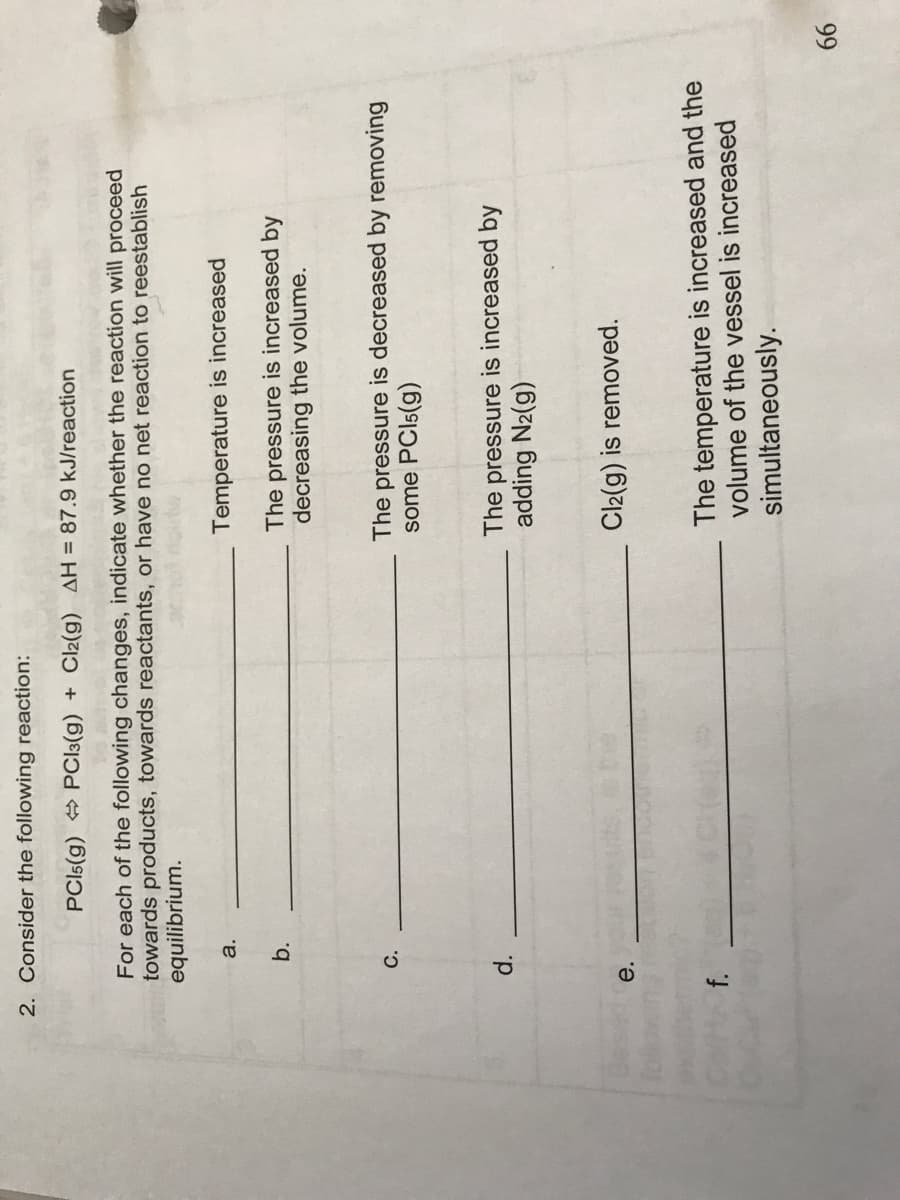C. 2. Consider the following reaction: PCI5(g) PCI3(g) + Cl2(g) AH = 87.9 kJ/reaction For each of the following changes, indicate whether the reaction will proceed towards products, towards reactants, or have no net reaction to reestablish equilibrium. a. Temperature is increased b. The pressure is increased by decreasing the volume. The pressure is decreased by removing some PCI5(g)
C. 2. Consider the following reaction: PCI5(g) PCI3(g) + Cl2(g) AH = 87.9 kJ/reaction For each of the following changes, indicate whether the reaction will proceed towards products, towards reactants, or have no net reaction to reestablish equilibrium. a. Temperature is increased b. The pressure is increased by decreasing the volume. The pressure is decreased by removing some PCI5(g)
Chemistry: Principles and Reactions
8th Edition
ISBN:9781305079373
Author:William L. Masterton, Cecile N. Hurley
Publisher:William L. Masterton, Cecile N. Hurley
Chapter8: Thermochemistry
Section: Chapter Questions
Problem 90QAP: Consider a metal ion A2+ and its nitrate salt, In an experiment, 35.00 mL of a 0.217 M solution of...
Related questions
Question
100%

Transcribed Image Text:d.
2. Consider the following reaction:
PCI5(g) PCI3(g) + Cl2(g) AH = 87.9 kJ/reaction
For each of the following changes, indicate whether the reaction will proceed
towards products, towards reactants, or have no net reaction to reestablish
equilibrium.
а.
Temperature is increased
b.
The pressure is increased by
decreasing the volume.
The pressure is decreased by removing
some PCI5(g)
The pressure is increased by
adding N2(g)
e.
Cl2(g) is removed.
The temperature is increased and the
volume of the vessel is increased
simultaneously.
f.
99
Expert Solution
Step 1
Since you have posted a question with multiple sub-parts, we will solve first three sub-parts for you. To get remaining sub-part solved please repost the complete question and mention the sub-parts to be solved.
The equilibrium is:
PCl5 (g) PCl3 (g) + Cl2 (g) H = 87.9 kJ/reaction
Trending now
This is a popular solution!
Step by step
Solved in 2 steps

Knowledge Booster
Learn more about
Need a deep-dive on the concept behind this application? Look no further. Learn more about this topic, chemistry and related others by exploring similar questions and additional content below.Recommended textbooks for you

Chemistry: Principles and Reactions
Chemistry
ISBN:
9781305079373
Author:
William L. Masterton, Cecile N. Hurley
Publisher:
Cengage Learning

Chemistry
Chemistry
ISBN:
9781305957404
Author:
Steven S. Zumdahl, Susan A. Zumdahl, Donald J. DeCoste
Publisher:
Cengage Learning

Chemistry: An Atoms First Approach
Chemistry
ISBN:
9781305079243
Author:
Steven S. Zumdahl, Susan A. Zumdahl
Publisher:
Cengage Learning

Chemistry: Principles and Reactions
Chemistry
ISBN:
9781305079373
Author:
William L. Masterton, Cecile N. Hurley
Publisher:
Cengage Learning

Chemistry
Chemistry
ISBN:
9781305957404
Author:
Steven S. Zumdahl, Susan A. Zumdahl, Donald J. DeCoste
Publisher:
Cengage Learning

Chemistry: An Atoms First Approach
Chemistry
ISBN:
9781305079243
Author:
Steven S. Zumdahl, Susan A. Zumdahl
Publisher:
Cengage Learning


Chemistry by OpenStax (2015-05-04)
Chemistry
ISBN:
9781938168390
Author:
Klaus Theopold, Richard H Langley, Paul Flowers, William R. Robinson, Mark Blaser
Publisher:
OpenStax

Chemistry: The Molecular Science
Chemistry
ISBN:
9781285199047
Author:
John W. Moore, Conrad L. Stanitski
Publisher:
Cengage Learning